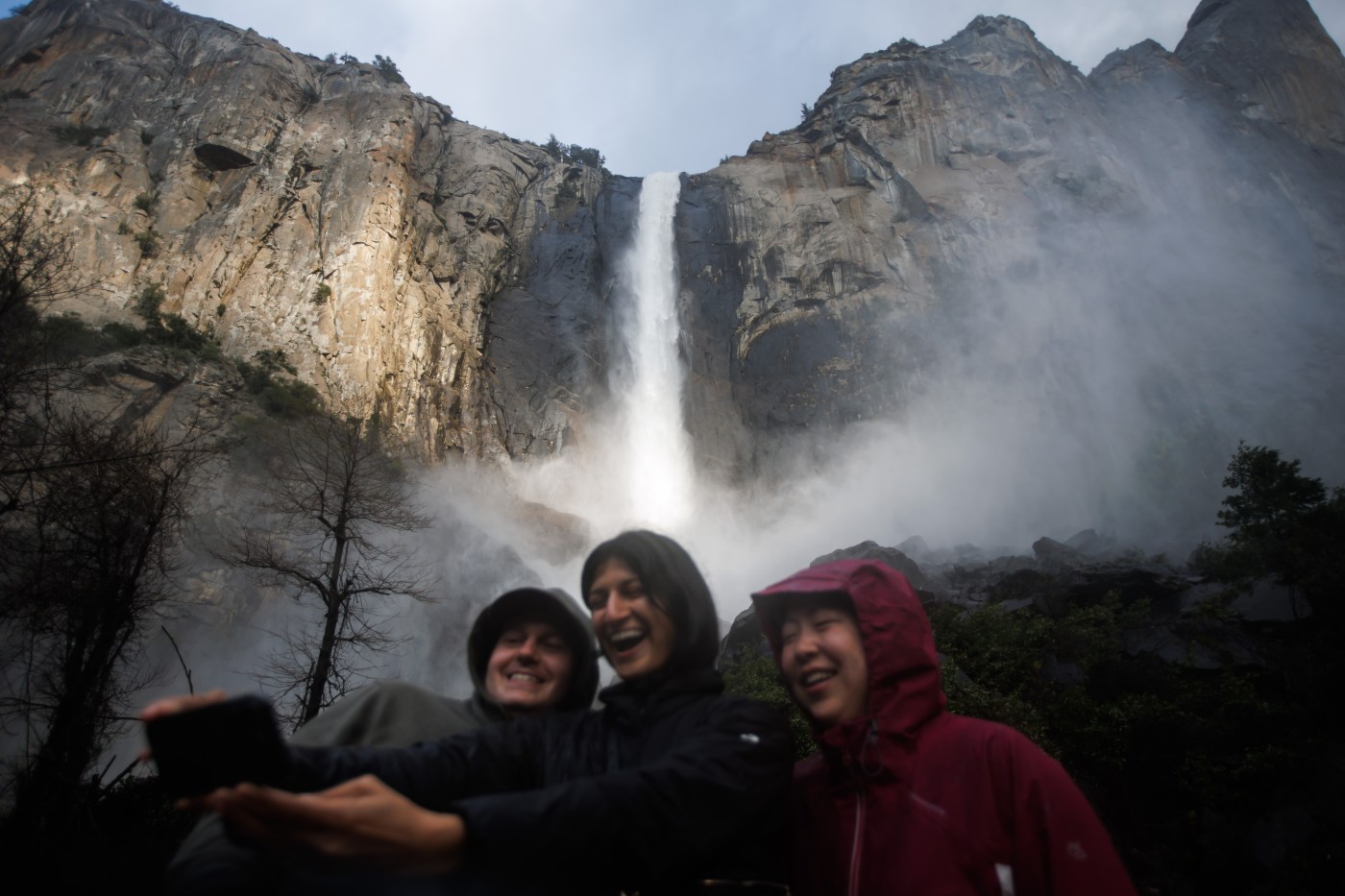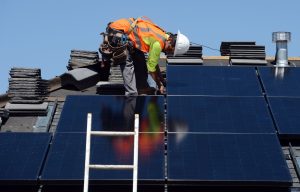Before they see Half Dome, Yosemite Falls, giant sequoias or other jaw-dropping attractions, the first stop for millions of visitors as they enter Yosemite National Park is Bridalveil Fall.
Yet for generations, the amenities at the base of the thundering, 620-foot waterfall on the western edge of Yosemite Valley have been a raging disappointment: Foul-smelling pit toilets dating back to the 1960s, crumbling asphalt pathways, a crammed dirt parking lot and narrow, slippery trails.
But now all of that is a bygone memory. Crews have finished a $19.3 million renovation, constructing a larger parking lot, modern flush toilets, interpretive signs, viewing platforms, wooden boardwalks, and wider hiking trails with more accessible features designed in the classic granite and timber national park style of the 1930s.
Visitor Lars Weber from Germany looks at Bridalveil Fall from one of the renovated trails at Yosemite National Park, Calif., on Tuesday, April 23, 2024. The park recently completed a $19.3 million dollar project that renovated trails, restrooms, viewing platforms, and interpretive signs. (Dai Sugano/Bay Area News Group)
Related Articles
Free National Park Day is coming on Saturday, April 20
Yosemite reservations will begin Saturday — here’s how they work
They scaled one of the world’s largest unclimbed rock faces. Blizzards and falling ice almost stopped them
The 10 most visited National Park Service sites in 2023 are …
The project is one of two major upgrades that visitors will discover this summer at Yosemite, along with a new $12.5 million visitor center built in the heart of the valley near the Village Store.
Both the falls and the new “Welcome Center” were funded by federal dollars, and matched with $12.2 million in private donations from the Yosemite Conservancy, a San Francisco-based nonprofit group that for years has helped improve the park’s features.
“Yosemite is a world-class destination,” said Frank Dean, president of the conservancy, and a former Yosemite ranger. “But it gets a lot of visitation, so things can tend to get worn down. You want to make a good first impression and do it well. The park just needs some TLC sometimes.”
At Bridalveil Fall, construction crews expanded the parking lot by 24 spaces to hold 80 cars. The infamous compost toilets with four stalls were torn down and replaced with 14 flush toilets in a modern building.
A new gathering, viewing, and orientation plaza was built near the restrooms. It includes benches and signs describing the history, wildlife and geology of the area. There are animal-proof trash and recycling receptacles, and re-routed loop trails, with two viewing platforms instead of one near the base of the falls.
The new Yosemite Valley Welcome Center is seen on Tuesday, April 23, 2024, in Yosemite National Park, California. (Dai Sugano/Bay Area News Group)
The work was completed in November. But because of winter snow, it is just being discovered by many visitors for the first time as spring has arrived.
“It’s spectacular,” joked Susan Codeglia, of Walnut Creek, who was beaming after finishing a hike to the falls on Tuesday afternoon. “If there was a drinking game every time somebody said ‘wow,’ we’d all be drunk.”
She was joined by her sister-in-law, Harriet Codeglia, of Groveland, a former Mountain View human resources manager who moved to the Sierra after she retired.
“It’s perfect. It’s fabulous,” she said. “It was treacherous before. The trails were slippery. I’ve been here when people fell down. It’s more accessible now. And so well thought out, the way everything is integrated with the rocks and the trees.”
Bridalveil Fall isn’t as tall as Yosemite Falls — which is four times as high. But it is remarkable in its own right, taller than the Washington Monument, three times taller than Niagara Falls, and one of the only waterfalls in Yosemite Valley that flows year round, whether or not California is in a drought — its swirling mists often producing rainbows in the afternoon.
Park Ranger Scott Gediman, center, swears in visitor Florence Hamel, 4, from Canada, as a junior ranger at the new Yosemite Valley Welcome Center on Tuesday, April 23, 2024, in Yosemite National Park, California. (Dai Sugano/Bay Area News Group)
It was named in 1856 by Warren Baer, editor of the Mariposa Democrat newspaper, who described the picturesque waterfall’s cascades as full of “ample folds, of the finest texture, the purest whiteness, and fringed with silver fleece or silken floss” like a bride’s veil.
“Bridalveil Fall is one of the iconic attractions of the park,” said Scott Gediman, a Yosemite spokesman. “There’s a lot of history here.”
President Teddy Roosevelt camped near the base of the falls with Sierra Club founder John Muir during a visit in 1903. The two sat around a campfire late into the night.
The other major new feature in Yosemite this spring is the Welcome Center. The $12.2 million facility, built in a former sports equipment shop in Yosemite Village, is intended to be an introduction to the park for many of the 4.5 million people who come each year from around the world.
Yosemite’s first visitor center, a rustic stone building, was built in 1925 in Yosemite Village. Another was built next door in 1966. The original building became the park’s museum, which today features Native American artifacts, paintings and photography exhibits. The 1966 building is now called the Exploration Center and features exhibits about history, geology, plants, wildlife and cultural heritage.
For decades, people could drive up and park outside both, then walk in, talk to rangers, ask questions about hikes, camping or other issues, and pick up maps and learn about the geology, plants, animals and human history of the famed 748,000-acre park.
But those parking spaces were removed when the park put in a shuttle bus system in the 1970s to deal with crowds and traffic. It became a half-mile walk from the main Yosemite Valley parking lot, tucked away amid groves of trees, shops, employee housing and park offices.
The new Welcome Center is adjacent to the parking lot. It features displays telling visitors which roads and campsites are open, how to protect their food from bears, where they can bike or hike, and other key details. Since the facility opened several months ago, visitor contacts with rangers are up 25%.
“People say ‘I’m here for a day, or 2 hours, or 4 hours. What can I do?” said Adonia Ripple, chief of Yosemite operations for the Yosemite Conservancy. “This helps them find a ranger — a flat hat — to ask. Before, the old visitor center was tucked away and kind of hard to find.”
Including the two new projects, the Yosemite Conservancy has provided $162 million since 2006 to renovate Yosemite Falls, Tunnel View, Olmstead Point, Mariposa Grove, and other iconic park locations.
“You don’t want worn-out, underserved facilities, or long lines for restrooms,” Dean said. “You want to make sure the experience is really up there, so that the accommodations match the scenery.”
Visitor Joanna Cwikla from New York talks photos of Bridalveil Fall, where a $19.3 million project was recently completed to renovate trails, restrooms, viewing platforms and interpretive signs, on Tuesday, April 23, 2024, in Yosemite National Park, California. (Dai Sugano/Bay Area News Group)












